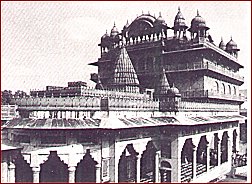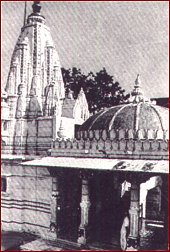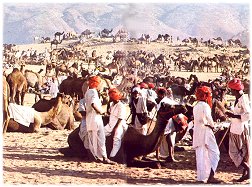STATES AND UNION TERRITORIES OF INDIA
RAJASTHAN
Ajmer
Ajmer was
founded by Raja Ajaipal Chauhan in the 7th century AD. It was under
the rule of the Chauhans until it was lost by Prithviraj Chauhan to Mohammed
Ghori. But later, Rana Kumbha of Mewar and Raja Maldeo of Marwar
reestablished Rajput rule here. It is situated about 130 kms South
West of Jaipur, at the foot of a hill.
Hinduism and
Islam co-exist here with the Pushkar temples, lake & the Dargah of
Khwaja Moinuddin Chisti.
Dargah
of Khwaja Moinuddin Chisti
is the tomb of
the Sufi Saint Khwaja Moinuddin Chisti (1142-1236 AD). Muslim devotees
visit during the Urs Mela of the saint, lasting 6 days. The devotees
sing Qawwals in praise of the saint's virtues and offer an embroidered
cloth called chadars at his grave. This shrine was visited by Akbar,
Shah Jehan, Jehangir. Emperor Akbar is said to have worshipped here
seeking the saint's blesiing for a son.
Nasiyan

This
is a red Digambara (Jain) temple built in the late 19th century.
In a double storeyed hall, there is a splendid display of wooden gilt representations,
glass engravings & paintings describing the Jain faith about the creation
of the world.
Adhai-Din-Ka-Jhonpara
is a mosque built
by Mohammed Ghori in 1193 AD in just two and a half days, considered to
be built on the ruins of a college and temples.
Lake
Ana Sagar
is a placid artificial
lake built in the 12th century by Anaji Chauhan and the embankment was
further beautified by the Moghul Emperors Jehangit and Shah Jehan.
Taragarh
Fort
was built
by Ajaipal Chauhan in the 7th century AD.
Pushkar
is the holy lake
of the Hindus. The town lies 11 kms form Ajmer and is seperated from
Ajmer by the Nag Pahar (Snake mountain). Near the lake is the Brahma
temple.It is believed
that Lord Brahma was looking for a suitable place for performing a vedic
yagna. A lotus from his hand fell on the earth and water is said
to have sprouted in the spot, which was Pushkar. This was the
holy spot chosen by Lord Brahma for his yagna.
 Brahma
Temple
Brahma
Temple
 Holy
dip in the Pushkar Lake
Holy
dip in the Pushkar Lake
 Camel
Mela
Camel
Mela
|